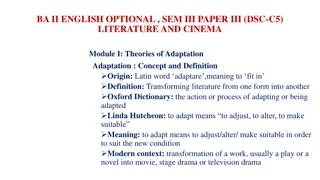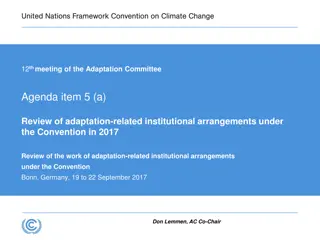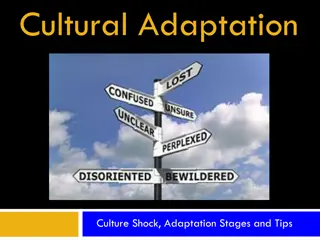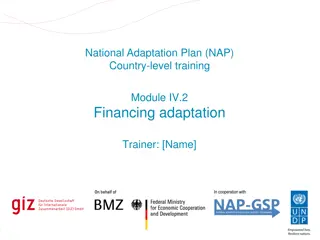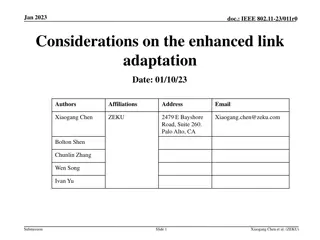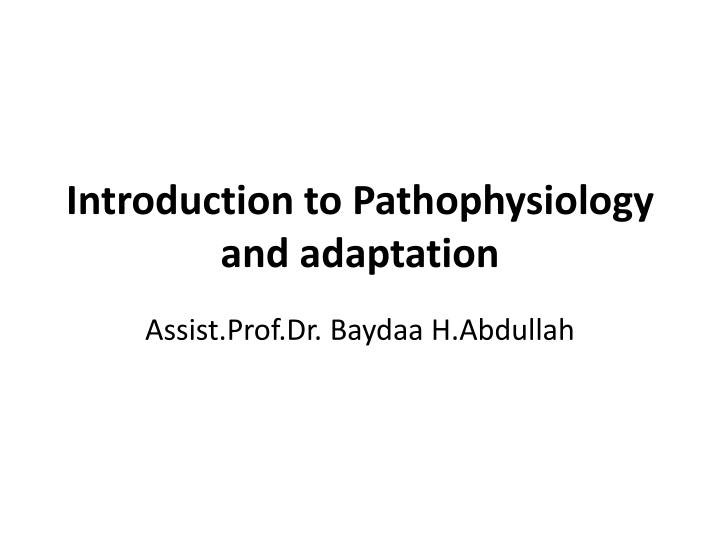
Introduction to Pathophysiology and Adaptation by Assist. Prof. Dr. Baydaa H. Abdullah
This content provides an insightful introduction to pathophysiology and adaptation by Assist. Prof. Dr. Baydaa H. Abdullah, offering valuable knowledge and understanding on these essential topics to aid in comprehensive learning and application in the field.
Download Presentation

Please find below an Image/Link to download the presentation.
The content on the website is provided AS IS for your information and personal use only. It may not be sold, licensed, or shared on other websites without obtaining consent from the author. If you encounter any issues during the download, it is possible that the publisher has removed the file from their server.
You are allowed to download the files provided on this website for personal or commercial use, subject to the condition that they are used lawfully. All files are the property of their respective owners.
The content on the website is provided AS IS for your information and personal use only. It may not be sold, licensed, or shared on other websites without obtaining consent from the author.
E N D
Presentation Transcript
Introduction to Pathophysiology and adaptation Assist.Prof.Dr. Baydaa H.Abdullah
Pathophysiology involves the study of functional or physiologic changes in the body that results from disease processes.
Diagnosis refers to the identification of a specific disease through evaluation of signs and symptoms. concerns the causative factors in a particular disease. When the cause of a disease is unknown. A disease that was caused by a treatment, a procedure, or an error . Etiology Idiopathic Iatrogenic Predisposing factors Pathogenesis Acute disease Encompass the tendencies that promote development of a disease in an individual. The development of the disease Short-term illness that develops very quickly with marked signs such as high fever or severe pain. Often a milder condition developing gradually. Exists in some conditions in which pathologic changes occur, but no obvious manifestations are exhibited by the patients. Chronic disease Subclinical Latent "Silent stage" which no clinical signs are evident, characterizes some disease. Incubation Time between exposure to the micoorganism and the onset of signs or symptoms. Generalized symptoms, period comprises the time in the early development of a disease. Lab test are negativeduring this time. Prodromal Manifestations of a disease Lesion Are the clinical evidence or effects, the signs and symptoms of a disease. Change in the tissue
Cell injury Cells can adjust their structure and function to accommodate the changes of the environment, this is called (adaptation)this is done by atrophy, hypertrophy, hyperplasia, metaplasia. If the cell exposed to injurious agent that exceed the adaptation capacity of the cell, then cell injury will develop, which is either reversible cell injury or irreversible ( death
Causes of cell injury Hypoxia, physical, chemical and drugs Microbial, immunological, genetic, nutritional, aging.
Hypoxia Is the most important and common cause of the cell injury and death, it means oxygen deficiency. Physical : *trauma *extreme of temperature *radiation *electric shock *sudden change in atmospheric pressure
3- chemical, drugs: Any chemical agent may cause injury even sugar &salt in high or low concentration affecting the osmotic environment which cause cell injury and death. *oxygen at high partial pressure.*poisons which may effect the membrane permeability, osmotic homeostasis integrity of enzymes. *air pollution *insecticides * CO *asbestos * therapeutic drugs *ethanol
4-microbial agents : Ranging from viruses to tapeworms including bacteria, fungi ,protozoa ,rickettsia 5-immunological : although the immune system serves to defend the body ,but it may cause cell injury e.g. in anaphylactic reaction to foreign protein or reaction to self antigen in number of autoimmune disease.
6- genetic defectsmany genetic defects are congenital malformations may cause pathological changes. 7- nutrition 8- aging
Types of cellular Adaptive-changes When cells are exposed to one of the noxious stimulus they will undergo one or more of the following types of adaptive changes:- i. Increased concentrations of normal cellular constituents. ii. Accumulate abnormal substances iii. Change the cellular size or number iv. Undergo a lethal change.
1-Aplasia (Agenesis): it means extreme failure of development of tissue or organ., or sometimes cell may not develop at all. This situation is caused by defective genetic instructions guiding development of cell populations, as a consequence an organ may not develop or Become small (only rudimentary tissue is present). *Aplasia usually affects the paired organs of the body like kidneys, adrenals, salivary glands, teeth,........etc.
3- Atrophy: Reduction in cell size and sometimes-number of the cells of an organ or tissue which was previously normal one which lead to decrease in the size of that organ or tissue. *atrophy does not appear at birth but it is acquired afterward throughout life.
Atrophy is of 2 types Physiological atrophy: (normal programmed reduction of cell size) e.g : thymus gland. Pathological atrophy : related to diseases
Causes of pathological atrophy: 1-Starvation atrophy: there is reduction in CHO, fat, followed by protein. There is general weakness, anaemia (emaciation) e.g. Cancer, chronic illness. 2-Ischaemic atrophy ; Due to decrease in blood supply which leads to shrinkage of the affected organ. gradual obstruction of the renal artery leads to ischaemic atrophy of the kidney , brain atrophy in cerebrovascular diseases.
3-Disuse atrophy: prolonged immobilization or decrease activity of the affected organ or tissue. e.g. wasting of the limb after fracture 4- Neuropathic atrophy: damage to the nerve supply e.g.: poliomyelitis . 5-Endocrine atrophy {hormonal atrophy}: Loss of endocrine regulatory mechanisme.g.hypopitutarism cause atrophyof the Thyroid , atrophy of the adrenals . 6-Pressure atrophy: prolong pressure on tissue causes atrophy . e.g.: pressure of tumor on the adjacent tissues, pressure on blood vessels etc.
7-Exhaustion atrophy: Due to over activity of the cell population may end with atrophy e.g.: atrophy of the thyroid, adrenals ....etc. 8-ldiopathic atrophy: the cause is unknown e.g. myopathies.of the bone
4-Hypertrophy: increase in cell size without increase in the number of these cells (the cells cannot be divided) e.g. cardiac muscle (left ventricular hypertrophy), skeletal muscle cells. The cause is due to increase functional demand or due to hormonal stimulation. It is of 2 types: physiological & pathological.
Pathological findings: " Gross: the organ is large, heavy. Microscopic: enlargment of cell size and nuclei Under E.M: increase in RNA, DNA, and increase number of organelles (mitochondria, endoplasmic reticulum.........etc).
5-Hyperplasia: increase in the numbers of the cells that cause increase in the size of the tissue or organ .it is usually occurs in tissues or organs (cells) that have the ability to divide (ability for mitosis). It is usually occurs with hypertrophy. It could be: *physiological: e.g.: compensatory hyperplasia of the kidney, benign prostatic hyperplasia (hypertrophy) in old age men related to high androgen levels. *pathological. Pathological findings: increase number of the cells, and increase mitotic figures.


